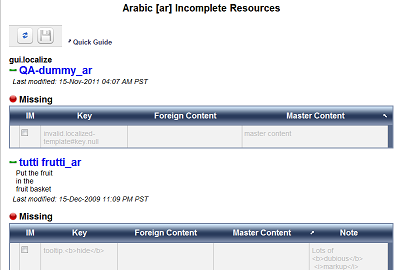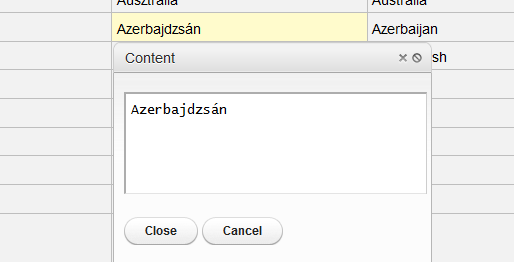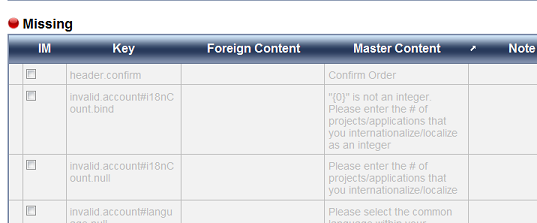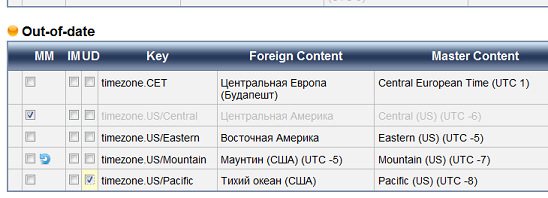j18n Tutorial
To-Do IDE
Plans: All
Navigation: Project Console (link: locale), To-do Menu (Translators only)
Here you can see and work on all of the incomplete messages for a particular locale;
i.e., multiple resources can be worked on all at the same time. This is extremely
useful when, e.g. you want to do a release and there are a few dozen incomplete
messages spread across many different resources.
Only missing and
out-of-date messages are shown and no super-resources are displayed.
If you want to see the contents of the full resource (complete messages as well
as any super-resources), just click on the resource name to view in the Foreign IDE
j18n defines a threshold for the maximum # of incomplete messages that can exist
for the To-do IDE to display. If the threshold is exceeded, a list of incomplete
resources for the locale is displayed instead. In all other respects, the To-do
IDE is functionally equivalent to the Foreign IDE.

Grids
For each incomplete resource, messages are separated into one of two possible grids (missing or out-of-date). In all grids, you can modify the foreign content, view history, revert changes, or change the state of a row. All changes are temporary until saving—you save all of your changes across all resources.
- Edit Foreign Content
Editing of content follows a similar pattern: first you select a cell (by Tab-bing
to it or clicking it); then you invoke the inline editor (by clicking again or
hitting ↵Enter/Return)
You then type in your content. You can either Cancel or Close (which writes the
new content to the cell). Of course you do not need to worry about Unicode escapes—
you just type as you would for any normal document.
Foreign content is restricted to 15 000 characters; excess text will be automatically truncated.

- Changing state
You can also change the state of a message (by checking the appropriate checkbox); if you do this, then any change you have made to the message's foreign content will be ignored. Which state changes are allowed depends upon which state a message is in (and is fully explained below). If you mark a message as (intentionally) missing, it appears grayed-out.
Missing
Missing messages indicate that there is no translation yet. Missing messages will not show up in a build and are incomplete. You can view the history of the master content. If you enter foreign content and then save the resource, the message will transition to up-to-date. You may also mark an message as intentionally missing; it still won't appear in a build, but will not be considered incomplete.

Out-of-date
Out-of-date messages indicate that the master content has changed since the last foreign content was provided. Out-of-date messages do show up in a build and are incomplete. By viewing history, you can see the version of the master content that was the basis for the last foreign content and exactly how the master has changed. If you enter foreign content and then save the resource, the message will transition to up-to-date. You may also mark the message as either missing or intentionally missing. In addition, you may mark a message as up-to-date, which simply means that the latest foreign content does not need to change to accommodate the latest master version. Note: marking an out-of-date message as up-to-date means that any change you have made to the message's foreign content will be ignored. So if you're just updating a message's foreign content do not also mark the message as up-to-date.

- Revert
You can revert any changes you made to a message's foreign content by clicking on the revert icon. Reverting only applies to the foreign content cell; if you want to revert a state change, just uncheck the checkbox. The presence of the revert icon indicates that a message's foreign content has changed.
- View History
In order to view previous versions for a message, click on the first (leftmost)
cell in the grid. The history panel shows previous versions of the message
resulting from either a change to the master or foreign content.
The history panel shows who made the master edit, the master content (you can
mouseover the master content to see when the edit was changed), the foreign content,
and who and when the foreign content edit was made. Think of each row as a
snapshot, revealing the state of the master and foreign content after
one of them was changed. If a foreign message was marked as missing, its content
will be shown as empty.

- Hiding Notes
You can hide (or show) the notes column; click on either the master content or notes header cell or click on the thick right edge of the grid.
Toolbar
Contains reset and save buttons. The save button is enabled once you have unsaved changes (for any message in any resource). You must save before any of your changes become permanent. Home will jump to the toolbar.
 Back to top
Back to top
Navigation
The IDE is designed so that you can do most of your work using only the keyboard. Moving backwards/forwards between cells (including between grids), invoking the editor, etc. does not require using the mouse.
| Tab | Go forward a cell |
| Shift+Tab | Go back a cell |
| Home | Jump to toolbar |
| Ctrl + | Zoom In |
| Ctrl - | Zoom Out |
| Ctrl+F | Search |
| Esc | Cancel (Editor) |
| Enter (Return) | Open Editor |